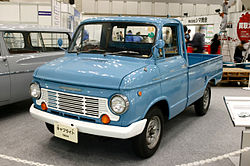Datsun Cablight
| Datsun Cablight | |
|---|---|
| Manufacturer: | Datsun |
| Production period: | 1958-1968 |
| Previous model: | none |
| Successor: | Datsun Cabstar |
The Datsun Cablight was a pickup truck that Datsun produced between 1958 and 1968. It was Nissan's base model among the commercial vehicles above the Datsun truck pickups . While the other commercial vehicles from Nissan / Datsun were getting bigger, it was decided to enter the segment of small trucks / commercial vehicles. At that time, this was served by models from Suzuki , the manufacturer Cony and HopeStar later taken over by Nissan . Nissan was also of the opinion that they could offer a good model in the previously unoccupied area and the success of the Cablight, which is popular at home and in export, took this into account. In 1968 the Cablight was replaced by the larger Datsun Cabstar .
Datsun Cablight A20 / A120 / A121 / A122 (1958–1964)
| A20 / A120 ´ / A121 / A122 | |
|---|---|
| Image does not exist | |
| Production period: | 1958-1965 |
| Designs: | Flatbed trucks , panel vans , minibuses |
| Engines: |
Otto engines : 0.9–1.0 liters |
| Length: | 3720 mm |
| Width: | 1603 mm |
| Height: | 1800 mm |
| Wheelbase: | 2220 mm |
The Cablight was an extremely inexpensive vehicle to build. With the exception of the hood and roof, all of the body panels were flat or curved. The front bumper was nothing more than a piece of metal with two inner curves, and the grille was a plump piece of sheet steel. What stood out were the so-called suicide doors that could be opened at the front . The minimalist design continued inside with a flat sheet metal as a dashboard with a speedometer and a few switches. There was no floor covering, there was no heating and no sound insulation or cladding. As a distinguishing mark, the lettering Cablight was applied to the bonnet and Datsun to the doors. The mechanics were also kept simple with the Datsun B-1 engine, which was a modified D-10 engine from the pre-war years. The four-cylinder petrol engine had 860 cm³ and made 27 hp. Using a 4-speed manual gearbox, the 1 being unsynchronized, it reached a top speed of 75 km / h. After production of the A20 flatbed truck began in August 1958 , which was also available as a panel van with a tarpaulin roof or a steel-roofed loading area , a double cab of the pickup followed in autumn 1958 with 2 + 2 or 2 + 3 seats and loading area, as well as delivery Van. The Delivery Van VA20 was a glazed version of the panel van, which was available as a 2-seater with a full load space or as a 2 + 2 (or 2 + 3) seats plus load space as a station wagon .
The revised Cablight A120 followed in 1961. They tried to give the model more style and so the sheets were designed a little more round. Inside there was now a glove compartment and a bench instead of the previous Spartan single bucket seats. But still the suicide doors were built in. As an identification mark next to the lettering Cablight on the bonnet, there was now a capital D with the lettering Datsun in the middle of the radiator grille. Neither the technology nor the variety of models had changed.
In 1963 the Cablight A121 appeared with a modified radiator grille and otherwise without any changes.
From January 1964 there was then Cablight A122. This had the 4-cylinder petrol engine called D-engine with 1046 cm³ of 40 HP. Apparently they wanted to test the willingness of customers to get more power for a surcharge because production ended at the end of February 1964.
Datsun Cablight A220 / A221 (1964–1968)
| A220 '/ A221 | |
|---|---|

Cablight A220 |
|
| Production period: | 1964-1968 |
| Designs: | Flatbed trucks , panel vans , minibuses |
| Engines: |
Petrol engines : 1.0-1.1 liters |
| Length: | 3840 mm |
| Width: | 1608 mm |
| Height: | 1710 mm |
| Wheelbase: | 2020 mm |
In March 1964 the completely renewed Cablight A220 was launched. This generation now had style and offered its own flair as a small, rounded truck. The suicide doors had disappeared, as had the minimalism of its predecessors. The upper part of the dashboard was now padded and there was now an instrument cluster from the old Datsun 220 with a speedometer, temperature gauge and fuel gauge. Again the model wore the lettering Cablight above the radiator grille on the bonnet and now an emblem on the front fenders that gave information about the capacities. The name Datsun or the emblem was nowhere to be found on the vehicle except in the middle of the steering wheel. In addition to the 1.0L D engine already used in the Cablight 122, there was now also the larger D11 engine. This four-cylinder petrol engine had a displacement of 1138 cm³ and made 53 hp. The pick-up A220, which was only available as a single cabin, was now also available with a folding side and rear steel structure as the A220 H. As a delivery van VA220, it was now offered either as a sheet-metal or glazed panel van, in addition to a 5-seater combination variant. In addition, there was now a 3 + 3 + 3 9-seater minibus KA220. In 1966 there was a minor revision with a new radiator grille, making the model series the 221. The series was produced until September 1968 and then replaced by the new Datsun Cabstar in October 1968 .